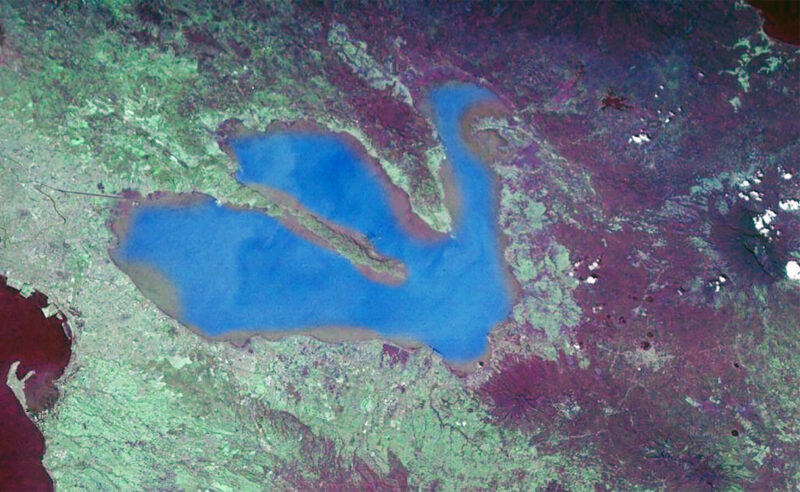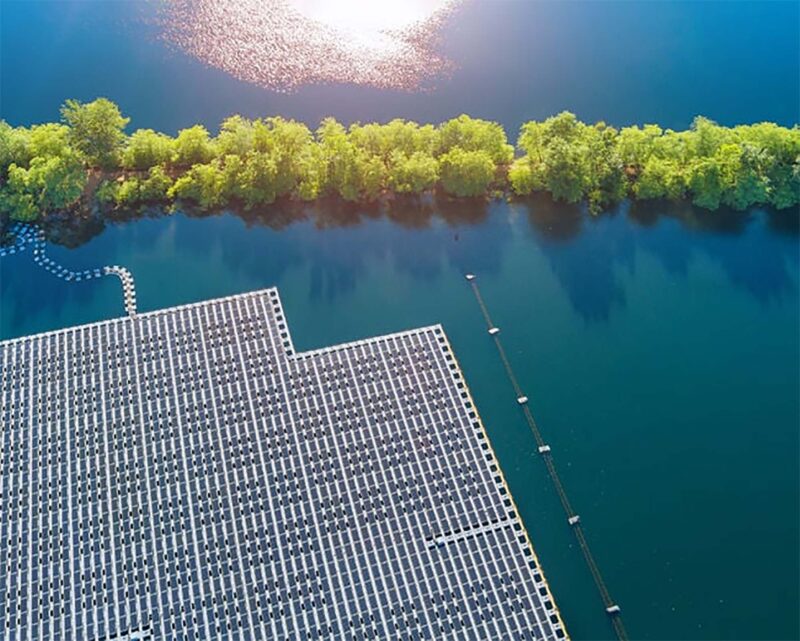
The power hungry Luzon grid, which feeds electricity to the National Capital Region of the Philippines, will in two years get additional supplies of power from three floating solar farms in Laguna Lake.
Luzon is the biggest island in the Philippines, an archipelago of over 7,100 islands.
Up to 2,000 hectares (~4,930 acres) of the 91,170 hectare (~227,000 acres) inland lake have been allocated to floating solar projects auctioned off by the Laguna Lake Development Authority (LLDA) with the recommendation of the Philippine Department of Energy (DoE). In the approval process, the LLDA has the final say in the allocation of projects to bidders.
The Laguna Lake spans part of the edges of Metro Manila, but mostly surrounds the province of Laguna. The solar projects are to be sited in 3 cities and 2 towns in the southern and eastern parts of the lake, farthest from where commercial operations are conducted in the lake.
So far, three companies have successfully closed contracts which are to be completed with the next two to four years.
ACEN has the biggest share of the grid pie with over a thousand megawatts of capacity and 8 contracts. This is followed by the partnership between Blueleaf Energy Asia Pte. Ltd., and SunAsia Energy, Inc. with 6 contracts and a commitment of 610.5 megawatts (MW). Vena Energy Corp. follows with 270 MW of capacity in one contract.
The total capacity of the 15 floating solar power contracts is 1,880.5 MW. This is equivalent to the electricity demand of over 2 million homes.
Most of the floating solar power projects in Laguna Lake are expected to be done by 2026. Once completed, when combined will be the largest floating solar power project in Southeast Asia.
ACEN Solar Project
Ayala-led ACEN Corp. committed to generate 1,100 MW, in 8 solar farm projects in the lake. This will be located on a total of 800 hectares (1,976 acres) broken up in various locations along the lake.
The LLDA pinpointed the southern and eastern areas on Laguna de Bay for floating solar projects. These are located closest to the boundaries of the cities of Calamba, Santa Rosa, and Cabuyao (less than 50 kilometers or 31 miles from the capital of Manila). Two other sites in the towns of Bay and Victoria in Laguna, about 70 kilometers (~44 miles) from the capital, were selected for their proximity to the Laguna grid.
The total area allocated is estimated to produce 2,500 MW of floating solar power.
ACEN won the bid for the 800-ha area in July 2023. The company is still in the pre-development stage, as it needs to secure the necessary permits before proceeding to construction. ACEN president and CEO John Eric Francia said that it would take two to three years for the project to open for commercial operation.
The floating solar project is a key part of ACEN’s master plan to achieve its 2030 goal of having a 20 gigawatt renewable energy portfolio. ACEN is also targeting to achieve net-zero carbon emissions by 2030.
The floating solar project is a major development for the Philippines’ renewable energy sector. The company aims to grow its renewable energy portfolio to 20 gigawatts (GW) by 2030. In the region it generates about 4.4 GW of power, attributable to facilities it operates in the Philippines, Australia, Vietnam, Indonesia, and India.
Compared to the SunAsia and BlueLeaf venture, the ACEN project can be considered the first large-scale floating solar project in the country with the capacity to generate enough electricity to power over 1 million homes.
BlueLeaf + SunAsia Solar Farms
SunAsia Energy, Inc. and Blueleaf Energy Asia Pte. Ltd. have won six solar energy operating contracts from the Department of Energy (DOE) for floating solar projects with a combined capacity of 610.5 MW. The projects will be located on Laguna de Bay, the largest freshwater lake in the Philippines, according to a report that appeared in BusinessWorld.
The floating solar facilities have the potential to generate 1.3 gigawatts of electricity, which is enough to power over 1 million homes. The projects are expected to involve an investment of between $1.5 billion and $1.7 billion.
The DOE has awarded a total of 237 solar energy contracts with an aggregate capacity of 1,282 MW and potential capacity of 21,452 MW. The agency is targeting to achieve 35% of renewable energy in the country’s energy mix by 2030.
The winning of the floating solar contracts by SunAsia Energy and Blueleaf Energy is a major step forward for the development of renewable energy in the Philippines. Floating solar is a promising technology that can help the country meet its renewable energy targets while also addressing the issue of land use.
The projects are expected to create jobs and boost the local economy. SunAsia Energy and Blueleaf Energy are committed to working with local communities to ensure that the projects are beneficial to all stakeholders.
The award of the floating solar contracts is a significant milestone for the Philippines’ renewable energy sector. It is a sign of the government’s commitment to developing renewable energy and a vote of confidence in the potential of floating solar.
BlueLeaf Pte Ltd Asia is a solar power company based in Singapore. The company is a leading provider of solar panels and systems in Asia. BlueLeaf has developed and operated over 2 GW of solar capacity across the globe, including projects in the Philippines, India, and Vietnam. The company is also actively involved in the development of floating solar projects and is committed to developing and delivering high-quality solar projects that help to reduce carbon emissions and improve air quality.
It is a portfolio company of Macquarie’s Green Investment Group (GIG). GIG is a global investment manager that invests in renewable energy and other sustainable infrastructure assets while working with local communities to ensure that its projects are sustainable and have a positive impact on the environment.
Vena Energy To The Laguna grid
The smallest in terms of generation capacity of the solar projects is the 270MW Vena Energy Floating Solar Farm, but it will be the most impactful to the province that hosts it. It has secured 200 hectares of land in the southern and eastern areas of Laguna de Bay (local name for Laguna Lake) which is closest to the Laguna grid.
This means the Vena Energy floating solar project will feed its power to the Laguna grid, which covers the provinces of Laguna, Rizal, and Quezon, directly supplying power needs of about 200,000 households and supplementing the 1,000 megawatts (MW) of power needed by the grid during peak hours.
Vena Energy is a leading player in the global solar energy industry. It is a subsidiary of Sembcorp Industries, a leading energy and urban development company with a portfolio of over 1.5 GW of solar projects in Asia and Australia. Vena Energy is also developing a 1.3-GW floating solar project in India.
Feeding The Most Power Hungry Grids

Aerial view of Laguna de Bay (Laguna Lake). Most of the floating solar farms will be located in the central and southern part of the lake away from human activities. (Satellite photo courtesy of Google Earth)
The floating solar power projects in Laguna Lake will supply power to both Metro Manila and Laguna — the most power hungry grids in the main island of Luzon.
According to the National Grid Corporation of the Philippines (NGCP), the Metro Manila grid requires around 6,000 MW of power during peak hours. This is the second highest power demand in the Philippines.

The Metro Manila grid is a sub-grid of the 12,235 MW Luzon grid. It covers the National Capital Region (NCR), which is home to the majority of the country’s population and industries. The Metro Manila grid is also connected to the Laguna grid, which means that power can be shared between the two grids.
The Laguna grid, on the other hand, feeds over 1,000 industries in Laguna, especially the ones located in the Sta. Rosa industrial zone which includes automobile assemblers Toyota and Mitsubishi and over locators manufacturing electronics products and accessories. The floating solar power projects intended to supply power to the province of Laguna are expected to generate enough electricity to power over 500,000 homes.
The floating solar power projects in Laguna Lake are part of the government’s plan to increase the use of renewable energy in the Philippines. The provincial government of Laguna approves of floating solar power as a promising renewable energy source because it is abundant, sustainable, and environmentally friendly. It is also expected to generate many jobs for the residents of the province.
I don’t like paywalls. You don’t like paywalls. Who likes paywalls? Here at CleanTechnica, we implemented a limited paywall for a while, but it always felt wrong — and it was always tough to decide what we should put behind there. In theory, your most exclusive and best content goes behind a paywall. But then fewer people read it! We just don’t like paywalls, and so we’ve decided to ditch ours. Unfortunately, the media business is still a tough, cut-throat business with tiny margins. It’s a never-ending Olympic challenge to stay above water or even perhaps — gasp — grow. So …




